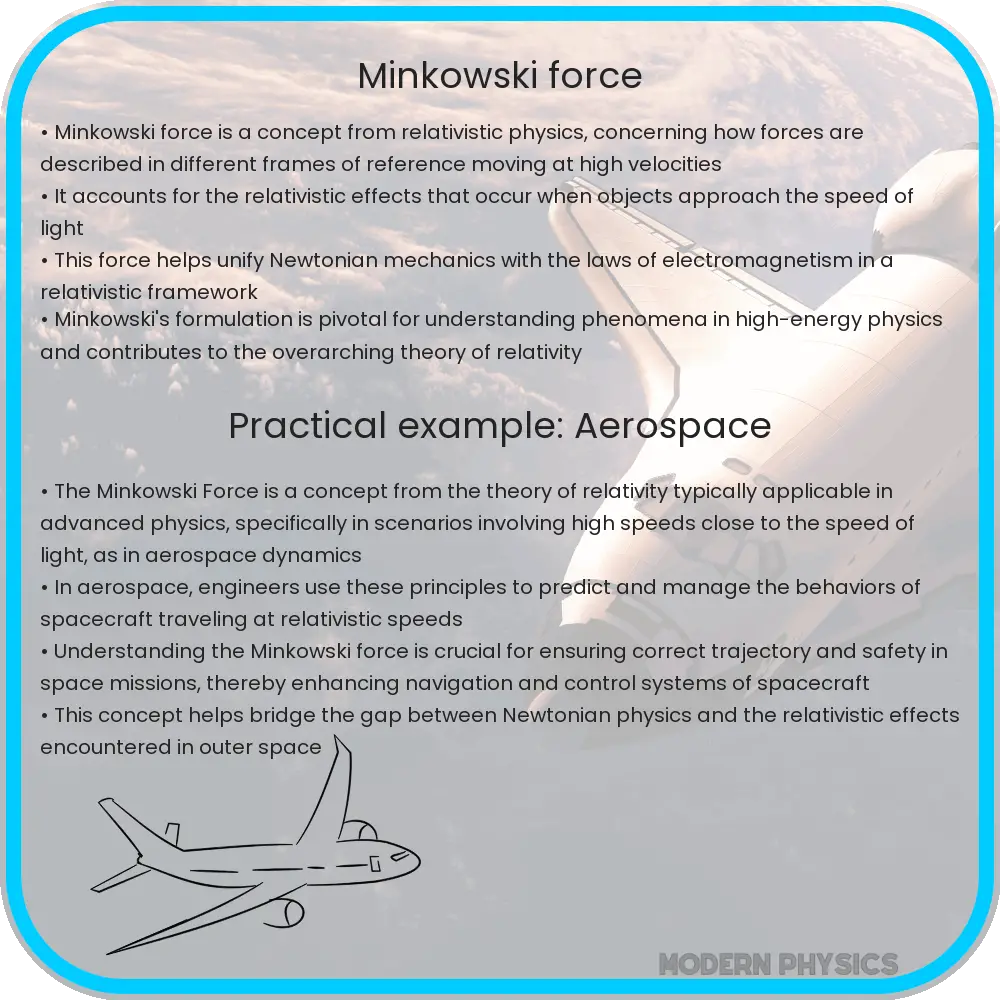Explore the concept of Minkowski Force in Special Relativity and its applications in particle physics and astrophysics. A deep dive into modern physics.

Understanding Minkowski Force in the Realm of Special Relativity and Dynamics
The concept of Minkowski Force is a fundamental aspect in understanding the dynamics within the framework of Special Relativity. Developed by Hermann Minkowski, this approach extends the traditional Newtonian mechanics into the relativistic domain, fundamentally altering our perception of force, time, and space. In this article, we delve into the intricacies of Minkowski Force and its implications in modern physics.
Special Relativity: A Brief Overview
Before exploring Minkowski Force, it’s crucial to have a foundational understanding of Special Relativity. Proposed by Albert Einstein in 1905, Special Relativity revolutionized the way we understand space and time. Its core principle is that the laws of physics are the same for all non-accelerating observers, and that the speed of light in a vacuum is constant, regardless of the motion of the light source or observer. This theory introduced concepts like time dilation and length contraction, which have profound implications in high-speed scenarios.
The Concept of Minkowski Force
Minkowski’s contribution to Special Relativity came in the form of a four-dimensional space-time continuum. Within this framework, he developed the concept of Minkowski Force. This force is not just a three-dimensional vector as in classical mechanics but a four-vector in space-time. This four-vector (or 4-force) includes not only the conventional three-dimensional force but also an energy component that is associated with the temporal dimension. Mathematically, it’s expressed as Fμ = dPμ/dτ, where Pμ is the four-momentum and τ is the proper time.
In Minkowski’s formulation, the dynamics of objects are governed by this four-vector force. The change in four-momentum is proportional to the Minkowski Force applied, taking into account both spatial and temporal changes. This approach allows for a seamless integration of mechanics with the principles of Special Relativity, providing a more comprehensive understanding of motion and forces at relativistic speeds.
One of the significant implications of Minkowski Force is in understanding the dynamics of particles moving at speeds close to the speed of light. In such scenarios, Newtonian mechanics fall short, as they do not account for relativistic effects. Minkowski’s formulation, however, aptly describes the behavior of such particles, incorporating the effects of time dilation and length contraction.
Application of Minkowski Force in Modern Physics
The application of Minkowski Force extends beyond theoretical physics into practical realms. In particle physics, especially in the operation of particle accelerators like the Large Hadron Collider (LHC), Minkowski’s formulation is crucial. As particles are accelerated to speeds nearing that of light, their dynamics can only be accurately described using the relativistic framework provided by Minkowski Force. This has been instrumental in predicting and observing phenomena like particle decay times, which differ significantly from those predicted by Newtonian mechanics.
Furthermore, Minkowski Force plays a vital role in the field of astrophysics. The behavior of objects in intense gravitational fields, such as near black holes, requires a relativistic treatment for accurate description. The concept of 4-force helps in understanding how the fabric of space-time is warped by massive objects, influencing the movement of nearby objects not just through traditional force but also through modifications in their temporal dimensions.
Challenges and Future Directions
Despite its profound implications, the concept of Minkowski Force is not without challenges. One significant challenge is the integration of this concept with Quantum Mechanics. The unification of the theories of the very large (General Relativity) and the very small (Quantum Mechanics) remains one of the biggest challenges in modern physics. Minkowski Force, rooted in the realm of Special Relativity, is a key player in this ongoing quest for a unified theory.
Future research in this area is likely to focus on exploring the implications of Minkowski Force in extreme conditions, such as those found in the early universe or inside black holes. These studies could provide deeper insights into the fundamental nature of the universe and lead to the development of new technologies based on relativistic physics.
Conclusion
In conclusion, Minkowski Force represents a pivotal advancement in the field of physics, extending the applicability of Newtonian mechanics to the relativistic domain. By incorporating the principles of Special Relativity into the dynamics of moving objects, it provides a more comprehensive understanding of the behavior of particles at high velocities. Its implications are far-reaching, influencing fields ranging from particle physics to astrophysics. As we continue to explore the universe, the role of Minkowski Force in understanding and describing the fundamental nature of reality becomes increasingly significant. This blend of classical mechanics and relativistic concepts not only challenges our traditional perceptions but also opens up new avenues for technological and scientific advancements.
